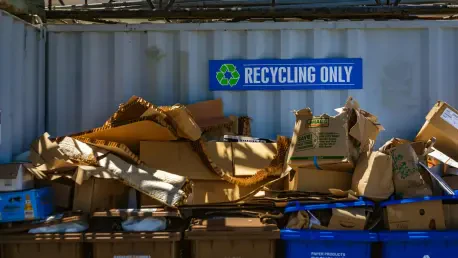In a world increasingly focused on sustainability, the unexpected downturn in U.S. paper recycling rates during 2024 has raised eyebrows among environmentalists and industry experts alike, prompting a closer examination of the factors at play. Despite decades of progress in building robust recycling systems, the latest data reveals a slight but notable decline in the percentage of paper and cardboard being recycled across the nation. This shift comes as a surprise, given the long-standing commitment of the paper industry to environmental stewardship and the active participation of millions of Americans in daily recycling efforts. The reasons behind this dip are multifaceted, involving both domestic achievements and international market challenges. As sustainability remains a critical goal, understanding the factors contributing to this decline offers valuable insights into the complexities of maintaining high recycling rates in a dynamic global economy. This discussion delves into the key drivers of the 2024 statistics, shedding light on what lies beneath the surface of this unexpected trend.
Domestic Recycling Efforts and Achievements
The U.S. paper industry has long been a leader in recycling, with millions of tons of paper processed each year through dedicated systems. In 2024, a staggering 46 million tons of paper were recycled, a testament to the infrastructure and public engagement that have been cultivated over decades. Although this volume remains impressive, the recycling rate for paper dropped to between 60 and 64 percent, down from a higher range in the previous year. For cardboard, the rate fell to 69 to 74 percent, reflecting a similar downward trend. Despite these declines, the industry’s commitment to sustainability shines through in other areas, particularly in the increased use of recovered fiber at domestic mills. This growth signals a positive shift toward relying more heavily on recycled materials in manufacturing processes, showcasing how mills are adapting to meet environmental goals even amidst challenges that impact overall recycling percentages.
A deeper look into domestic efforts reveals significant strides in manufacturing capacity that bolster recycling initiatives. In 2024, U.S. mills utilized 32.7 million tons of recovered fiber to create new products, marking an increase of over a million tons compared to the prior year. This uptick is largely attributed to voluntary investments in new and modernized facilities, which have added substantial capacity for producing containerboard and packaging paper using entirely recycled materials. Over the past two decades, the share of recovered fiber in total fiber consumption at mills has climbed to 44.4 percent, a clear indicator of the industry’s pivot toward sustainable practices. These advancements demonstrate that, while overall recycling rates may have dipped, the foundation for future growth remains strong as domestic production increasingly prioritizes recycled inputs over virgin resources, setting a promising trajectory for long-term environmental impact.
Challenges in International Markets
While domestic recycling efforts show progress, external factors have played a significant role in the 2024 decline in overall rates. A notable challenge has been the reduced demand for recovered fiber in international markets, particularly in Asia, which historically has been a major destination for U.S. recycled paper exports. This drop in export demand has directly contributed to the lower recycling percentages, as fewer tons of paper are being diverted from landfills through overseas channels. Industry leaders have pointed out that softer-than-expected international demand has offset some of the gains made within the U.S., highlighting how global economic fluctuations can impact local sustainability metrics. This situation underscores the interconnected nature of recycling systems, where international trends can ripple back to affect domestic outcomes in unexpected ways.
Adding to the complexity of the export challenge is the changing landscape of paper-based packaging entering the U.S. market. In 2024, a 13.5 percent increase in net containers arriving in the country boosted the volume of recyclable material available. While this influx could be seen as an opportunity to enhance recycling efforts, it also places additional pressure on systems already grappling with reduced export outlets. The combination of higher domestic supply and lower international demand creates a bottleneck, where not all available material can be efficiently processed or redirected. This dynamic illustrates the delicate balance between supply and demand in the recycling ecosystem, revealing how external market conditions can complicate even the most well-intentioned sustainability strategies. Addressing these international challenges will require innovative approaches to finding new markets or enhancing domestic processing capabilities.
Looking Ahead to Sustainable Solutions
Reflecting on the 2024 data, it became evident that the slight decline in U.S. paper and cardboard recycling rates was influenced by a mix of domestic progress and international setbacks. The industry’s steadfast dedication was clear in the increased use of recovered fiber at home, yet the impact of weaker export markets, especially in Asia, could not be ignored. As stakeholders assessed the year’s outcomes, the focus shifted toward actionable steps for the future. Enhancing domestic mill capacity and exploring alternative international markets emerged as critical strategies to counteract export declines. Additionally, fostering greater public awareness and participation in recycling programs was seen as vital to maintaining high recovery volumes. By investing in innovation and building stronger global partnerships, the paper industry aimed to navigate past challenges and reinforce its role as a driver of sustainability, ensuring that future years would reflect a renewed upward trend in recycling achievements.









